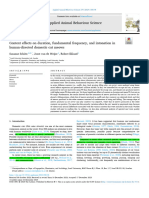Professional Documents
Culture Documents
Human Perception of Emotions From Canis Familiaris Barks: An Auditory-Perceptual Study
Human Perception of Emotions From Canis Familiaris Barks: An Auditory-Perceptual Study
Original Title
Copyright
Available Formats
Share this document
Did you find this document useful?
Is this content inappropriate?
Report this DocumentCopyright:
Available Formats
Human Perception of Emotions From Canis Familiaris Barks: An Auditory-Perceptual Study
Human Perception of Emotions From Canis Familiaris Barks: An Auditory-Perceptual Study
Copyright:
Available Formats
Volume 9, Issue 4, April – 2024 International Journal of Innovative Science and Research Technology
ISSN No:-2456-2165 https://doi.org/10.38124/ijisrt/IJISRT24APR313
Human Perception of Emotions from Canis familiaris
Barks: An Auditory-Perceptual Study
Varun Singh1, Jim Saroj Winston 2*
1
Assistant Professor, Dr. Shakuntala Misra National Rehabilitation University, India.
2
Assistant Professor, Nitte Deemed to be University, India.
*
Corresponding Author ; Jim Saroj Winston 2*
Abstract:- This study investigates how experience and Frequency Modulation), amplitude (Relative Amplitude and
gender influence the perception of emotions in dog barks. Abrupt Onset), and duration (Pulse Duration and Pulse
Drawing from Morton's structural-motivational rule and Repetition) as reported by Lord, Feinstein, and Coppinger
previous research on mammalian vocalizations, we aimed (2009). According to Waldman (1972), an animal's emotional
to discern whether humans, especially those experienced state can be analogous to human emotions. Morton (1977),
with dogs, can accurately identify emotions such as based on bird and mammalian vocalizations, hypothesized
stranger, anger, lonely, and play in dog barks. Using that low-pitch (atonal) vocalizations signal aggressive
recordings of Indian Lesser Spitz barks in various intentions, in contrast to high-pitch (tonal) vocalizations
contexts, we conducted auditory-perceptual experiments signaling friendly and submissive intentions.
with two groups: experienced listeners (with more than 2-
3 years of pet dog experience) and non-experienced Dogs (Canis familiaris) are integral to many households
listeners. Participants listened to bark sequences and and are aptly referred to as man's best friend. Earlier studies
identified the corresponding emotions. Results revealed have proved that dogs emit acoustically different barks in
that experienced listeners consistently outperformed non- different situations, suggesting that emotional changes in dogs
experienced ones in identifying emotions, except for are reflected in barking vocalizations (Feddersen-Petersen,
'play,' where no significant difference was observed. 2000; Yin, 2002; Pongracz et al., 2005). A similar study on
Gender did not significantly affect emotion perception. the vocalization system of wolves revealed that acoustic
Interestingly, 'anger' was most accurately identified features of vocalizations vary with intentions or internal state
across both groups, followed by 'stranger,' 'play,' and (Schassburger, 1993). Further, Linnankoski et al. (1994)
'lonely' emotions. Analyzing open-ended responses, we interestingly reported that humans could identify the emotions
found that acoustic cues such as pitch and inter-bark of a macaque from its vocalizations. Pongracz et al. (2005)
intervals strongly influenced emotional perception. investigated the effect of acoustic parameters of dog barks on
'Stranger' barks were described as low-pitched, while human listeners, and results revealed that barks recorded in
'anger' barks had shorter inter-bark intervals. 'Lonely' different situations had distinctive acoustic patterns regarding
barks were characterized by high pitch and longer inter- harmonic-to-noise ratio, fundamental and peak frequency and
bark intervals than 'play' barks. These findings suggest inter-bark intervals conveying emotional information for
that experience plays a crucial role in accurately human listeners.
perceiving emotions in dog barks, aligning with the
concept of a common mammalian heritage in emotional Pongracz et al. (2005) proposed the possibility of a
communication. Gender differences were negligible in common mammalian heritage in the acoustic communication
this context. Understanding the acoustic cues underlying of emotions. The common mammalian heritage theory
emotional expression in dogs enhances our postulates that during the evolution of species from lower-
comprehension of canine behavior and has implications order to higher-order organisms, the basic principles of
for fields like animal welfare and neuroscience. Further acoustic processing schemes might also have been transferred.
research could delve deeper into the mechanisms
underlying emotional perception in non-verbal All people (including children) make everyday
communication across mammalian species. judgments of emotions when listening to their fellow beings,
even though they may be inexperienced. One might be using
Keywords:- Emotions, Canis Familiaris, Human Perception, the same perceptual schemes for perceiving emotion intensity
Emotion Perception. in non-human vocalizations (e.g., dog barks), which is used
for perceiving emotion in human infant cries and in adult
I. INTRODUCTION speech.
Emotions reflect the internal status of an organism and The present study conducted an auditory-perceptual
help a second person evaluate the internal status of his fellow experiment to explore humans' ability to identify emotions
organism. Emotions can be expressed or comprehended from dog bark. Under the perceptual analysis of emotions, the
through variations in various acoustic parameters of vocal aim of the present study was threefold: (i) The primary aim
signals, such as frequency (Tonality, Noise, Mean Pitch, and was to investigate the influence of experience and gender in
IJISRT24APR313 www.ijisrt.com 282
Volume 9, Issue 4, April – 2024 International Journal of Innovative Science and Research Technology
ISSN No:-2456-2165 https://doi.org/10.38124/ijisrt/IJISRT24APR313
the perception of 4 target emotions: stranger, anger, lonely, adding 30 seconds of silence after each 15 seconds of bark as
and play (happy). (ii) The secondary aim of the study was to response time for human listeners. Three bark sequences
find the order of identification of emotions, i.e., which were made, each consisting of barks from four different
emotion is perceived most accurately and vice versa. (iii) The contexts arranged randomly.
tertiary aim of the study was to determine the possible
implication of the "common mammalian heritage" model in The bark sets were copied into a compact disk (CD) and
the perception of emotion using the present findings. played on a computer via Philips SHP2000 headphones
(frequency response: 15-22000Hz) to the participants. The
II. METHODS listeners had to listen to each bark set and identify the context
in which it was recorded. The listeners' responses were
A. Participants collected using a quaternion forced choice condition in which
Two groups of individuals participated in the study. they had to put a tick mark (√) in the box corresponding to
Group 1 included twenty experienced listeners, ten males and the context. The experimenter handled the player. The bark
ten females in the age range of 18-24 years (mean age=21.0 sequence sets were played back individually to the listeners,
years) who had a minimum of 2-3 years of experience with who were allowed to listen to each set only once. However, a
pet dogs of any breed, and the second group included twenty particular context bark from a bark set was repeatedly played
non-experienced listeners, ten males and ten females in the back at the listeners' request. After listening to 3 bark sets,
age range of 18-24 years (mean age=20.6 years) who did not the listeners were asked to mention the unique features that
have any experience with dogs. distinguished one emotion from the others in an open-choice
manner.
B. Recording of Stimulus
A three-year-old female dog from the Indian Lesser III. RESULTS
Spitz (Canis familiaris) variety participated in the study. This
breed's characteristic feature is that it is a watchdog known The results of the present study are discussed under four
for excessive barking. Bark recordings were collected in four headings: (a) Experienced versus non-experienced listeners,
contexts at the owner's home. All barks were recorded by the (b) Experienced males versus experienced females, (c) Non-
experimenters directly. The four contexts were; experienced males versus non-experienced females, and (d)
Stranger: The experimenter was a stranger to the dog and Order of identification of emotions.
would arrive at the house gate in the owner's absence. The
owner was asked to stay inside the house during bark A. Experienced versus Non-Experienced Listeners
recordings. Dog barking was elicited and recorded during Experienced listeners identified all four emotions more
the experimenter's appearance at the house's gate for 1-2 correctly than non-experienced listeners. The emotion 'anger'
minutes. was identified correctly and accurately by almost all
Lonely: The owner tied the lash of the dog to a tree at one experienced listeners, followed by the emotion 'stranger' and
corner of the house and walked away, out of sight of the 'lonely.' The emotion 'play' was least identified by the
dog. The recorder was kept at a distance of 0.5-1 meter, experienced listeners, though it was correctly identified by
and dog barks were recorded for 1-2 minutes. 75% of the participants. Table 1 shows the percentage of
Play: The owner was asked to play a usual game with the correct identification of emotions by experienced versus non-
dog, such as catching the ball. The experimenter recorded experienced listeners.
barks elicited at a distance of 0.5-1 meter for 1-2 minutes.
Anger: The owner was asked to stand near the dog, and Table 1 Percentage of Experienced and Non-Experienced
one of the experimenters pretended to be hitting the Listeners Who Gave >50% of Correct Identification of
owner. The barks elicited were recorded at a distance of Emotions
0.5-1 meter for 1-2 minutes. Group 1 Group 2
Emotions Z p
(%) (%)
Recordings were made directly by the experimenters Stranger 90 30 3.8730 0.0001*
with a built-in omnidirectional microphone (frequency range Lonely 80 40 2.5830 0.0098*
16 Hz-12000 Hz) of a Sony Walkman digital media player Play 75 70 0.3541 0.7233
(NWZ-E443, Sony Corp, China). During the recording of the Anger 100 80 2.1082 0.0350*
barks, the distance between the dog and the recorder was
maintained at 0.5-1 meter constantly, and barks emitted A test of equality of proportion was conducted to find
during each context were recorded for 1-2 minutes. Two the statistically significant difference in the correct
visits were made on two different days, and two sets of identification of emotions (>50%) between the two groups.
recordings were made for each of the four contexts. The statistical analysis results revealed that the experienced
listeners identified the emotions more accurately than non-
C. Auditory-Perceptual Experiment experienced listeners. This was significant at 0,05
Barks of 15 seconds that accurately represented the significance level for the emotions' stranger', 'lonely,' and
target emotions (four in number: Anger, stranger, lonely, and 'anger.' There was no statistically significant difference
play) were selected perceptually by three experimenters of between the experienced and non-experienced listeners for
this study. Stimuli were assembled using Adobe Audition the emotion 'play.'
software version 3.0 (Adobe Systems, Incorporated) by
IJISRT24APR313 www.ijisrt.com 283
Volume 9, Issue 4, April – 2024 International Journal of Innovative Science and Research Technology
ISSN No:-2456-2165 https://doi.org/10.38124/ijisrt/IJISRT24APR313
B. Gender Effect on Experienced Listeners Table 4 Friedman Test Results for Rank of Identification of
Experienced female listeners identified two target the Emotions
emotions, 'stranger' and 'play,' correctly than experienced Ranks 1 2 3 4 p
male listeners. On the other hand, emotions like 'lonely' and Experienced Anger Stranger Play Lonely
'anger' were identified similarly by both experienced males 0.001*
listeners (3.08) (2.50) (2.23) (2.20)
and experienced females. The equality of proportions test Non-
results revealed no statistically significant difference between Anger Play Lonely Stranger
experienced 0.000*
experienced males and females in correctly identifying target (3.35) (2.63) (2.13) (1.90)
listeners
four emotions. Table 2 shows the percentage of experienced
male and female listeners correctly identified the four target Table 4 indicates that the order of identification of
emotions. emotions from best to least was anger, stranger, play, and
lonely for experienced listeners and anger, play, lonely, and
Table 2 Percentage of Experienced Male and Female stranger for non-experienced listeners. Also, the Wilcoxon
Listeners Who Gave >50% of Correct Identification of signed rank test was done to find out which emotion pair was
Emotions better identified.
Males
Emotion Females (%) Z p
(%) Table 5 shows the Wilcoxon signed rank test results for
Stranger 80 100 1.4907 0.1360 pair-wise comparison of emotions for experienced and non-
Lonely 80 80 0 1 experienced listeners. Wilcoxon signed rank test revealed
Play 70 80 0.5164 0.6056 that the emotion pairs like 'lonely-stranger,' 'anger-stranger,'
Anger 100 100 - - 'anger-lonely,' and 'anger-play' significantly differ (p<0.05)
among experienced listeners. The pairs' play-stranger', 'anger-
C. Gender Effect in Non-Experienced Listeners stranger,' 'anger-lonely,' and 'anger-play' showed significant
Non-experienced female listeners correctly identified identification differences among non-experienced listeners
two target emotions, 'stranger' and 'lonely,' unlike non- (p<0.05).
experienced male listeners. On the other hand, emotion like
'play' was identified correctly by most non-experienced male Table 5 Results of Wilcoxon Signed Rank Test for Pair-Wise
listeners compared to non-experienced female listeners. The Comparison
equality of proportions test results revealed no statistically Emotion pairs Experienced Non-experienced
significant difference between non-experienced males and listeners listeners
females in correctly identifying target four emotions. Table 3 Z P Z P
shows the percentage of non-experienced male and female lonely - stranger -1.633 .102 -1.026 .305
listeners correctly identified the four target emotions. play - stranger -.682 .495 -2.553 .011*
*
anger-stranger -2.232 .026 -3.625 .000*
Table 3 Percentage of Non-Experienced Male and Female play - lonely -.736 .461 -1.586 .113
Listeners Who Gave >50% of Correct Identification of anger - lonely -2.716 .007* -2.819 .005*
Emotions anger - play -2.558 .011* -2.252 .024*
Males Females
Emotion Z p
(%) (%) Listeners were asked to describe the perceptual
Stranger 20 40 0.9759 0.3291 characteristic of each bark in an open-ended fashion that cued
Lonely 20 60 1.8257 0.0679 them to differentiate one type of emotion from the other. The
Play 80 60 0.9759 0.3291 listeners described "stranger" emotion as low pitch bark and
Anger 80 80 0 1 "anger" bark as having short inter-bark intervals. "Play" and
"lonely" bark were described as high-pitch barks, out of
D. Order of Identification of Emotions which "lonely" bark had more inter-bark interval and high
The rank of emotions identified from most to least tonality than "play" bark.
accurately identified was evaluated using the Friedman non-
parametric test among experienced and non-experienced IV. DISCUSSION
listeners. The Friedman test results found a significant
difference in the rank of identification of emotions between The results of the present study indicated that
the groups. Table 4 shows the results of the Friedman test for experienced listeners could identify the emotions' anger,
the order of identification of emotions (mean values were stranger, and lonely' (negative emotions) better than non-
mentioned in parentheses). experienced listeners. This finding is in agreement with the
results of the Pongracz et al. (2005) study, where people with
different experiences with dogs were asked to describe the
emotional content of several artificially assembled bark
sequences based on five emotional states (aggressiveness,
fear, despair, playfulness, and happiness). Pongracz et al.
reported that experienced dog owners could correctly identify
the target emotions more than the non-experienced. Also, the
IJISRT24APR313 www.ijisrt.com 284
Volume 9, Issue 4, April – 2024 International Journal of Innovative Science and Research Technology
ISSN No:-2456-2165 https://doi.org/10.38124/ijisrt/IJISRT24APR313
findings of the present study are in consonance with earlier schemes' for perceiving emotions in various vocalizations.
findings of behavioral and neuro-imaging studies for parents' Also, the role of a "common mammalian heritage" in acoustic
and non-parents perception of emotions from human infant communication, as mentioned by Pongracz et al. (2005), is
cry, the results of which reveal that parents perform better evident, especially in the perception of emotions.
than non-parents (Green et al., 1987 & Seifritz et al., 2003).
Both the experienced and non-experienced listeners
The identification of the emotion 'play' (a positive described that the unique cues of emotions were in
emotion) was unaffected by the listeners' experience. accordance with Morton's Structural-motivational rules
According to the most widely held view, the right (1977), which articulates that the pitch, inter-bark intervals,
hemisphere dominates the left hemisphere in the perception and tonality were found to have solid cues for the perception
and expression of emotions (Strauss & Moscovitch, 1981; of emotions in dog barks for human listeners.
Campbell, 1978; Chaurasia & Goswami, 1975; Safer, 1981).
Seifritz et al. (2003) found that in the right amygdala and V. CONCLUSION
interconnected limbic regions, non-parents showed relatively
more robust activation for positive emotions, and parents The results showed that communication between
showed relatively stronger activation for negative emotions. humans and dogs is based on the basic principles of
mammalian communication (perceptual processing schemes)
Among the experienced and non-experienced listeners, and follows Morton's structural-motivational rules.
regardless of gender, ' anger' was the best-identified emotion. Interestingly, the results generally aligned with earlier studies
This may be better understood because 'anger' is an on infant cry perception and animal communication,
expression signaling the hostile intentions of perceived emphasizing the role of "common mammalian heritage" in
persons (Hortsmann, 2003). Therefore, it is possible that in the acoustic communication of emotions.
human evolutionary history, perceiving anger and preparing
for a possible attack was more profitable than ACKNOWLEDGMENT
underestimating signals of potential danger and not
anticipating the attack. In contrast, underestimating the The authors would like to thank the management of their
expression of happiness would not have such negative parent institutes and all the participants for facilitating this
consequences (Biele et al., 2006). study at all junctures.
Statistically significant gender differences were not REFERENCES
evident in the identification of emotions in the present study.
Similar findings were reported by Westbrook (1976) in the [1]. Biele, C., & Grabowska, A. (2006). Sex differences in
perception of emotions in 49 males and 51 females, with no perception of emotion intensity in dynamic facial
gender difference. Leger et al. (1996) reported no gender expression. Experimental Brain Research, 171(1), 1-6.
difference in human infant cry perception in adults. It should [2]. Campbell, R. (1978). Asymmetries in interpreting and
be admitted, however, that in some studies on human expressing a posed facial expression. Cortex, 19, 327-
emotion perception, gender differences were observed, 342.
suggesting that gender effects are dependent upon procedural [3]. Chaurasia, B. D., & Goswami, H. K. (1975). Functional
variables that can influence subjects' performance (Biele et asymmetry in the face. Acta Anatomica, 91, 154-160.
al., 2006). [4]. Feddersen-Petersen, D., 2000. Vocalization of European
wolves (Canis lupus lupus L.) and various dog breeds
Earlier studies on human infant cry perception in adults (Canis lupus f. familiaris). Archiv fu¨r
have demonstrated that adults can discriminate between cries Tierzucht/Archives Animal Breeding, 43(4), 387–397.
emitted widely discrepant circumstances (e.g., birth and pain [5]. Green, J.A., Jones, L. E., & Gustafson GE. (1987).
cries) (Wasz-Hockert et al., 1968). However, Gustafson and Perception of cries by parents and non-parents: Relation
Harris (1990) reported poor performance in perceiving more to cry acoustics. Developmental Psychology, 23, 370-
closely related ones (i.e., hunger vs. pain cry). Similar 382.
findings were found in the present study, where the listeners [6]. Gustafson, G. E., & Harris, K. L. (1990). Women's
could discriminate between barks with discrepant responses to young infants' cries. Developmental
characteristics but not between those with closely related Psychology, 26, 144-152.
characteristics. [7]. Hopkins, B. (2000). Development of crying in normal
infants: Method, theory and some speculations. In:
Results of the present study hint that the emotion Crying as a sign, a symptom, & a signal: Clinical
perception from dog bark points to the fact that humans can emotional and developmental aspects of infant and
perceive emotions from the vocalizations of mammals based toddler crying. (Barr, R. G., Hopkins, B, et al., Ed), pp
on perceptual-acoustic characteristics. This was evident from 176-209. New York, NY, US: Cambridge University
the earlier studies on infant cry perception. Vocalizations of Press.
mammals (human infants, dogs, wolves, and macaques) in [8]. Hortsmann, G. (2003). What do facial expressions
different circumstances have been proven to have different convey: Feeling states, behavioral intentions or action
acoustic characteristics (in earlier studies). All these may requests. Emotion, 3(2), 150-166.
indicate that we might use the same 'perceptual processing
IJISRT24APR313 www.ijisrt.com 285
Volume 9, Issue 4, April – 2024 International Journal of Innovative Science and Research Technology
ISSN No:-2456-2165 https://doi.org/10.38124/ijisrt/IJISRT24APR313
[9]. Leger, D.W., Thompson, R.A., Merritt, J.A., & Benz,
J.J. (1996). Adult perception of emotion intensity in
human infant cries: Effects of infant age and cry
acoustics. Child Development, 67, 3238–3249.
[10]. Linnankoski, L., Laakso, M., Aulanko, R., Leinonen, L.
(1994). Recognition of emotions in macaque
vocalizations by children and adults. Language and
Communication, 14, 183-192.
[11]. Lord, K., Feinstein, K., & Coppinger, R. (2009).
Barking and mobbing. Behavioral Processes, 81, 358-
368.
[12]. Safer, M. A. (1981). Sex and hemisphere differences in
access to codes for processing emotional expressions
and faces. Journal of Experimental Psychology:
General, 110, 86-100.
[13]. Schassburger, R. M. (1993). Vocal communication in
the Timber Wolf, Canis lupus Linnaeus: Structure,
Motivation, and Ontogeny. Berlin Germany: Paul Parey
Scientific Publishers.
[14]. Scheiner, E., Hammerschmidt, K., Jurgens, U., &
Zwirner, P., (2002). Acoustic analysis of developmental
changes and emotional expression in the pre-verbal
vocalizations of infants. Journal of voice, 16(4), 509-
529.
[15]. Seifritz, E., Esposito, F., Neuhoff, J.F., Luthi, A.,
Mustovic, H., Dommann, G., Bardeleben, U.V., Radue,
E.W., Cirillo, S., Tedeshi, G., & Di Salle, F. (2003).
Differential sex-independent amygdala response to
infant crying and laughing in parents versus non-
parents. Biological Psychiatry, 54, 1367-1375.
[16]. Strauss, E., & Moscovitch, M. (1981). Perceptual
asymmetries in processing facial expression and facial
identity. Brain and Language, 13, 308-322.
[17]. Simonov, V.P., (1986). The Emotional Brain:
Physiology, Neuroanatomy, Psychology & Emotion.
New York: Plenum Press.
[18]. Leont’ev and Sudakov (1978). The Great Soviet
Encyclopedia 3rd Edition.
[19]. Morton, E.S. (1977). On the occurrence and
significance of motivation-structural rules in some bird
and mammal sounds. American Naturalist, 111, 855–
869.
[20]. Pongra´cz, P., Molna´r, C.S., Miklo´si, A., & Csa´nyi,
V. (2005). Human listeners are able to classify dog
barks recorded in different situations. Journal of
Comparative Psychology, 119, 136–144.
[21]. Waldman, R. (1972). Cited in V. P. Simonov. (1986).
The Emotional Brain: Physiology, Neuroanatomy,
Psychology & Emotion. New York: Plenum Press.
[22]. Wasz-Höckert, O., Lind, J., Vuorenkoski, V., Partanen,
T., & Valanné, E. (1968). The Infant Cry: A
Spectrographic and Auditory Analysis. Clinics in
Developmental Medicine No. 29. London: Spastics
International Medical Publications.
[23]. Westbrook, M. (1976). Sex differences in the perception
of emotion. Journal of Consulting and Clinical
Psychology, 26(2), 139-146.
[24]. Yin, S. (2002). A new perspective on barking in dogs.
Journal of Comparative Psychology, 116, 189–193.
IJISRT24APR313 www.ijisrt.com 286
You might also like
- STL2C5Document9 pagesSTL2C5Marcela Coid50% (6)
- AP Human Geography Chapter 5 NotesDocument15 pagesAP Human Geography Chapter 5 NotesSeth Adler82% (44)
- Research 1Document6 pagesResearch 1LIZA80% (10)
- AdjectiveDocument10 pagesAdjectiveTC Nelinho CandidoNo ratings yet
- Branding Essentials Ebook & Checklist PDFDocument13 pagesBranding Essentials Ebook & Checklist PDFEdin ParallangajNo ratings yet
- Lesson Plan For ParaphrasingDocument4 pagesLesson Plan For ParaphrasingCris TapiaNo ratings yet
- Bow Grade7 Q1 Q4Document119 pagesBow Grade7 Q1 Q4ariane galenoNo ratings yet
- Human Listeners Are Able To Classify Dog (Canis Familiaris) Barks Recorded in Different SituationsDocument9 pagesHuman Listeners Are Able To Classify Dog (Canis Familiaris) Barks Recorded in Different SituationsMolnár Csaba / Csaba MolnarNo ratings yet
- Anthropomorphic Interpretations and Ethological Descriptions of Dog and Cat Behavior by Lay People - Anthrozoos - 12 (4) 1999 p.205Document6 pagesAnthropomorphic Interpretations and Ethological Descriptions of Dog and Cat Behavior by Lay People - Anthrozoos - 12 (4) 1999 p.205Rocio Quezada SilvaNo ratings yet
- Applied Animal Behaviour Science: Veronika Konok, Krisztina Nagy, Ádám MiklósiDocument10 pagesApplied Animal Behaviour Science: Veronika Konok, Krisztina Nagy, Ádám MiklósiSusanna BianchiNo ratings yet
- RSBL 2013 0926Document5 pagesRSBL 2013 0926Susanna BianchiNo ratings yet
- Writing39c hcp3Document8 pagesWriting39c hcp3api-317131714No ratings yet
- Context Effects On Duration, Fundamental Frequency, and Intonation in Human-Directed Domestic Cat MeowsDocument8 pagesContext Effects On Duration, Fundamental Frequency, and Intonation in Human-Directed Domestic Cat MeowsReza PandayNo ratings yet
- Animal Emotions: Exploring Passionate Natures: ArticlesDocument18 pagesAnimal Emotions: Exploring Passionate Natures: ArticlesViv LorteNo ratings yet
- Dogs Can Discriminate Barks From Different SituationsDocument9 pagesDogs Can Discriminate Barks From Different SituationsMolnár Csaba / Csaba MolnarNo ratings yet
- Article SummaryDocument4 pagesArticle Summaryapi-260817278No ratings yet
- Cimpanezi Si Exprimare EmotiiDocument11 pagesCimpanezi Si Exprimare Emotiimyhaela_marculescuNo ratings yet
- Applied Animal Behaviour Science: Gabriella Tami, Anne GallagherDocument11 pagesApplied Animal Behaviour Science: Gabriella Tami, Anne GallagherSusanna BianchiNo ratings yet
- 1 s2.0 S0376635709001727 MainDocument4 pages1 s2.0 S0376635709001727 MainLucy BrittainNo ratings yet
- PsiAnim14 PDFDocument5 pagesPsiAnim14 PDFAlex IavorschiNo ratings yet
- Orgãos Sensitivos Dos CavalosDocument20 pagesOrgãos Sensitivos Dos CavalosWesley TrindadeNo ratings yet
- Formisano 2009 Sound Categories Are Represented As 2Document6 pagesFormisano 2009 Sound Categories Are Represented As 2Rubén Alcalá ArgüellesNo ratings yet
- 2017 Do We Understand What It Means For Dogs To Experience EmotionDocument4 pages2017 Do We Understand What It Means For Dogs To Experience EmotionmarciascognamilloNo ratings yet
- Final DraftDocument15 pagesFinal Draftapi-299261601No ratings yet
- Bottlenose Dolphins Can Use Learned Vocal Labels To Address Each OtherDocument6 pagesBottlenose Dolphins Can Use Learned Vocal Labels To Address Each OtherStefana MaximNo ratings yet
- Familiarity and Voice RepresentationDocument9 pagesFamiliarity and Voice Representationarts.lamiaaaldawyNo ratings yet
- Digit Synaesthesia - A Case Study Using A Stroop-Type Test - Mills, 1999Document11 pagesDigit Synaesthesia - A Case Study Using A Stroop-Type Test - Mills, 1999Rowan LunchNo ratings yet
- Human Non-Linguistic Vocal Repertoire: Call Types and Their MeaningDocument28 pagesHuman Non-Linguistic Vocal Repertoire: Call Types and Their MeaningMorlaNo ratings yet
- Do Animals Have Emotions?: PUREC DAVID, VM, GR.2.5.09Document13 pagesDo Animals Have Emotions?: PUREC DAVID, VM, GR.2.5.09Viv LorteNo ratings yet
- The highly sensitive dog: making life easier for these wonderful dogsFrom EverandThe highly sensitive dog: making life easier for these wonderful dogsNo ratings yet
- 2017 Communicating Canine and Human EmotionsDocument7 pages2017 Communicating Canine and Human EmotionsmarciascognamilloNo ratings yet
- Abstract: This Research Paper Delves Into The Significance of The "Arf" Sound in CanineDocument2 pagesAbstract: This Research Paper Delves Into The Significance of The "Arf" Sound in CanineAybern BawtistaNo ratings yet
- Analyses and PlaybackDocument21 pagesAnalyses and PlaybackIvan P GlNo ratings yet
- Bruce Bienenstock Documented Essay 5 JulDocument11 pagesBruce Bienenstock Documented Essay 5 JulJessa Mae NazNo ratings yet
- Schotz Vdweijer PerceptionOfCatIntonationSP14Document6 pagesSchotz Vdweijer PerceptionOfCatIntonationSP14Jeravin QuizanaNo ratings yet
- Perception of Hoarseness by Several Classes of Listeners ANDERS 1988Document10 pagesPerception of Hoarseness by Several Classes of Listeners ANDERS 1988Aude JihelNo ratings yet
- 0956 CH05Document26 pages0956 CH05Felipe MatheusNo ratings yet
- Science - Adh3428 SMDocument41 pagesScience - Adh3428 SMcps15No ratings yet
- Unige 102028 Attachment01Document15 pagesUnige 102028 Attachment01supiboboNo ratings yet
- Ultrasonic Vocalization in Rats PDFDocument8 pagesUltrasonic Vocalization in Rats PDFBüşra YılmazNo ratings yet
- Animal Cognition: Why Do Rabbits Have Big Ears? Nursing Time Stimulation by Vocal Playback of Rabbit PupsDocument8 pagesAnimal Cognition: Why Do Rabbits Have Big Ears? Nursing Time Stimulation by Vocal Playback of Rabbit PupsNilson EvilásioNo ratings yet
- Sensory Processing Sensitivity AronDocument24 pagesSensory Processing Sensitivity AronagustinaNo ratings yet
- HCP DraftDocument7 pagesHCP Draftapi-291241313No ratings yet
- Gebhart 2009Document5 pagesGebhart 2009David EspitiaNo ratings yet
- Alger Cat CultureDocument20 pagesAlger Cat CultureMäti Nuñez del PradoNo ratings yet
- Pride Paper Final 3Document15 pagesPride Paper Final 3api-477139378No ratings yet
- Empathy in RatsDocument12 pagesEmpathy in Ratstrantuanan123No ratings yet
- Randall Fontes - Wikipedia, The Free EncyclopediaDocument5 pagesRandall Fontes - Wikipedia, The Free EncyclopediaDavid 'Arroyos' KobzaNo ratings yet
- Angantyr Et Al 2011Document9 pagesAngantyr Et Al 2011deltanueveNo ratings yet
- Ling 121 Group 1 BSED Eng 1HBDocument8 pagesLing 121 Group 1 BSED Eng 1HBAllen BianzonNo ratings yet
- Neural Correlates of The Pitch of Complex Tones. I. Pitch and Pitch SalienceDocument19 pagesNeural Correlates of The Pitch of Complex Tones. I. Pitch and Pitch SalienceCaractacusFigulus100% (1)
- Comportamiento BubaDocument10 pagesComportamiento Bubaangel mtzNo ratings yet
- JPSP Aron and Aron 97 Sensitivity Vs I and N PDFDocument24 pagesJPSP Aron and Aron 97 Sensitivity Vs I and N PDFInés DoradoNo ratings yet
- BJPpseudo PsychicDocument18 pagesBJPpseudo PsychicFrabato BardonNo ratings yet
- Lima2013 Article WhenVoicesGetEmotionalACorpusODocument12 pagesLima2013 Article WhenVoicesGetEmotionalACorpusObordian georgeNo ratings yet
- Are There Basic Emotions Ekman PDFDocument4 pagesAre There Basic Emotions Ekman PDFzeax79No ratings yet
- Binaural BeatsDocument7 pagesBinaural BeatsShubham MishraNo ratings yet
- The Effect of Food and Music To Spatial Memory of Hamsters in T-MazeDocument10 pagesThe Effect of Food and Music To Spatial Memory of Hamsters in T-MazeMoreno MJNo ratings yet
- HCP Revised FINALDocument9 pagesHCP Revised FINALNatalieNo ratings yet
- The Ability To Recognize Dog Emotions Depends On The Cultural Milieu in Which We Grow UpDocument9 pagesThe Ability To Recognize Dog Emotions Depends On The Cultural Milieu in Which We Grow UpSusanna BianchiNo ratings yet
- Examen Inglés de La Comunidad de Madrid (Extraordinaria de 2004) (WWW - Examenesdepau.com)Document1 pageExamen Inglés de La Comunidad de Madrid (Extraordinaria de 2004) (WWW - Examenesdepau.com)Emma RNo ratings yet
- Nihms 751939Document12 pagesNihms 751939Veronica MartinezNo ratings yet
- Animal Liberation (1975), in Which He Argues in Favor of Vegetarianism, and His EssayDocument3 pagesAnimal Liberation (1975), in Which He Argues in Favor of Vegetarianism, and His Essayapi-399653876No ratings yet
- 1 IntroduzioneDocument59 pages1 IntroduzionemuramadNo ratings yet
- Neonate Movement Is Synchronized With Adult SpeechDocument3 pagesNeonate Movement Is Synchronized With Adult SpeechMarie Christine laznikNo ratings yet
- 2002ElfenbeinMeta PDFDocument33 pages2002ElfenbeinMeta PDFSelenaNo ratings yet
- Assessment of Integrated Poultry Manure and Synthetic Fertilizer Effects on Maize (Zea mays) Growth and Soil Properties: A Study from Bayero University, KanoDocument15 pagesAssessment of Integrated Poultry Manure and Synthetic Fertilizer Effects on Maize (Zea mays) Growth and Soil Properties: A Study from Bayero University, KanoInternational Journal of Innovative Science and Research Technology100% (1)
- Seasonal Variation and Distribution Patterns of Endophytic Community in Withania SomniferaDocument7 pagesSeasonal Variation and Distribution Patterns of Endophytic Community in Withania SomniferaInternational Journal of Innovative Science and Research TechnologyNo ratings yet
- Utilizing Chicken Eggshells and Waste Glass Powder as Cement Fillers for Environmental StabilityDocument6 pagesUtilizing Chicken Eggshells and Waste Glass Powder as Cement Fillers for Environmental StabilityInternational Journal of Innovative Science and Research TechnologyNo ratings yet
- Personal Capabilities of The Non-Teaching Personnel and Client SatisfactionDocument8 pagesPersonal Capabilities of The Non-Teaching Personnel and Client SatisfactionInternational Journal of Innovative Science and Research TechnologyNo ratings yet
- Transforming Challenges to Victories: An Inquiry on Transformational Leadership of School Leaders in the Public Elementary SchoolsDocument54 pagesTransforming Challenges to Victories: An Inquiry on Transformational Leadership of School Leaders in the Public Elementary SchoolsInternational Journal of Innovative Science and Research TechnologyNo ratings yet
- The Influence of Continuance Commitment on Job Satisfaction of Barangay Health Workers in Malaybalay City, BukidnonDocument14 pagesThe Influence of Continuance Commitment on Job Satisfaction of Barangay Health Workers in Malaybalay City, BukidnonInternational Journal of Innovative Science and Research TechnologyNo ratings yet
- Intelligent Clinical Documentation: Harnessing Generative AI For Patient-Centric Clinical Note GenerationDocument15 pagesIntelligent Clinical Documentation: Harnessing Generative AI For Patient-Centric Clinical Note GenerationInternational Journal of Innovative Science and Research TechnologyNo ratings yet
- Exploring The Potential Advantages of Traditional Therapies in Autoimmune Blistering Illnesses: A Comprehensive Review and Analysis, ResearchDocument12 pagesExploring The Potential Advantages of Traditional Therapies in Autoimmune Blistering Illnesses: A Comprehensive Review and Analysis, ResearchInternational Journal of Innovative Science and Research TechnologyNo ratings yet
- Meta Land: Redefining Virtual Communities Through Centralized Governance, Inclusivity and InnovationDocument5 pagesMeta Land: Redefining Virtual Communities Through Centralized Governance, Inclusivity and InnovationInternational Journal of Innovative Science and Research TechnologyNo ratings yet
- Solar Based Multilevel Inverter F o R BLDC Motor DriveDocument8 pagesSolar Based Multilevel Inverter F o R BLDC Motor DriveInternational Journal of Innovative Science and Research TechnologyNo ratings yet
- Skin Disease Detection and Remedial SystemDocument7 pagesSkin Disease Detection and Remedial SystemInternational Journal of Innovative Science and Research TechnologyNo ratings yet
- Design and Development of Multi-Featured Medical StretcherDocument4 pagesDesign and Development of Multi-Featured Medical StretcherInternational Journal of Innovative Science and Research TechnologyNo ratings yet
- EmoConnect: Nurturing Trust and Relationship Bonds in Alzheimer's ConversationsDocument3 pagesEmoConnect: Nurturing Trust and Relationship Bonds in Alzheimer's ConversationsInternational Journal of Innovative Science and Research TechnologyNo ratings yet
- Unlocking Sentiments: Enhancing IOCL Petrol Pump ExperiencesDocument8 pagesUnlocking Sentiments: Enhancing IOCL Petrol Pump ExperiencesInternational Journal of Innovative Science and Research TechnologyNo ratings yet
- Smart and Secure Home With ChatbotDocument9 pagesSmart and Secure Home With ChatbotInternational Journal of Innovative Science and Research TechnologyNo ratings yet
- Preparation and Identification of Magnetic Iron Nanoparticle Based On A Natural Hydrogel and Its Performance in Targeted Drug DeliveryDocument17 pagesPreparation and Identification of Magnetic Iron Nanoparticle Based On A Natural Hydrogel and Its Performance in Targeted Drug DeliveryInternational Journal of Innovative Science and Research TechnologyNo ratings yet
- Development of Smart Ground Fault Location Model For Radial Distribution SystemDocument14 pagesDevelopment of Smart Ground Fault Location Model For Radial Distribution SystemInternational Journal of Innovative Science and Research TechnologyNo ratings yet
- Fall Detection and Boundary Detection in Care HomesDocument7 pagesFall Detection and Boundary Detection in Care HomesInternational Journal of Innovative Science and Research TechnologyNo ratings yet
- Application of Plant Growth Promoting Rhizobacteria On Vegetative Growth in Chili Plants (Capsicum Frutescens L.)Document7 pagesApplication of Plant Growth Promoting Rhizobacteria On Vegetative Growth in Chili Plants (Capsicum Frutescens L.)International Journal of Innovative Science and Research TechnologyNo ratings yet
- Exploring The Post-Annealing Influence On Stannous Oxide Thin Films Via Chemical Bath Deposition Technique: Unveiling Structural, Optical, and Electrical DynamicsDocument7 pagesExploring The Post-Annealing Influence On Stannous Oxide Thin Films Via Chemical Bath Deposition Technique: Unveiling Structural, Optical, and Electrical DynamicsInternational Journal of Innovative Science and Research TechnologyNo ratings yet
- Reading Intervention Through "Brigada Sa Pagbasa": Viewpoint of Primary Grade TeachersDocument3 pagesReading Intervention Through "Brigada Sa Pagbasa": Viewpoint of Primary Grade TeachersInternational Journal of Innovative Science and Research TechnologyNo ratings yet
- Firm Size As A Mediator Between Inventory Management Andperformance of Nigerian CompaniesDocument8 pagesFirm Size As A Mediator Between Inventory Management Andperformance of Nigerian CompaniesInternational Journal of Innovative Science and Research TechnologyNo ratings yet
- Application of Game Theory in Solving Urban Water Challenges in Ibadan-North Local Government Area, Oyo State, NigeriaDocument9 pagesApplication of Game Theory in Solving Urban Water Challenges in Ibadan-North Local Government Area, Oyo State, NigeriaInternational Journal of Innovative Science and Research TechnologyNo ratings yet
- Global Warming Reduction Proposal AssessmentDocument6 pagesGlobal Warming Reduction Proposal AssessmentInternational Journal of Innovative Science and Research TechnologyNo ratings yet
- On The Development of A Threat Driven Model For Campus NetworkDocument14 pagesOn The Development of A Threat Driven Model For Campus NetworkInternational Journal of Innovative Science and Research TechnologyNo ratings yet
- Detection of Phishing WebsitesDocument6 pagesDetection of Phishing WebsitesInternational Journal of Innovative Science and Research TechnologyNo ratings yet
- A Study To Assess The Knowledge Regarding Teratogens Among The Husbands of Antenatal Mother Visiting Obstetrics and Gynecology OPD of Sharda Hospital, Greater Noida, UpDocument5 pagesA Study To Assess The Knowledge Regarding Teratogens Among The Husbands of Antenatal Mother Visiting Obstetrics and Gynecology OPD of Sharda Hospital, Greater Noida, UpInternational Journal of Innovative Science and Research TechnologyNo ratings yet
- PHREEQ C Modelling Tool Application To Determine The Effect of Anions On Speciation of Selected Metals in Water Systems Within Kajiado North Constituency in KenyaDocument71 pagesPHREEQ C Modelling Tool Application To Determine The Effect of Anions On Speciation of Selected Metals in Water Systems Within Kajiado North Constituency in KenyaInternational Journal of Innovative Science and Research TechnologyNo ratings yet
- Mandibular Mass Revealing Vesicular Thyroid Carcinoma A Case ReportDocument5 pagesMandibular Mass Revealing Vesicular Thyroid Carcinoma A Case ReportInternational Journal of Innovative Science and Research TechnologyNo ratings yet
- Esophageal Melanoma - A Rare NeoplasmDocument3 pagesEsophageal Melanoma - A Rare NeoplasmInternational Journal of Innovative Science and Research TechnologyNo ratings yet
- Introduction To Digital Advocacy Planning, Management andDocument11 pagesIntroduction To Digital Advocacy Planning, Management andJablack Angola MugabeNo ratings yet
- Sociocultural Contexts EN12Lit-Ie-28: 21 Century Literature From The Philippines and The WorldDocument3 pagesSociocultural Contexts EN12Lit-Ie-28: 21 Century Literature From The Philippines and The WorldPaul Pabilico PorrasNo ratings yet
- Detailed Lesson Plan in Mathematics 3 Odd and Even NumberDocument5 pagesDetailed Lesson Plan in Mathematics 3 Odd and Even NumberZoren Fajarito75% (8)
- CS459 - Introduction To Services Computing: Course InformationDocument2 pagesCS459 - Introduction To Services Computing: Course InformationDan KimNo ratings yet
- ASG Report D. Munca-AftenevDocument12 pagesASG Report D. Munca-AftenevDaniela Munca-AftenevNo ratings yet
- Communication at WorkDocument298 pagesCommunication at Workk7g2kpjxn9No ratings yet
- UNIT 1 Education-DikonversiDocument7 pagesUNIT 1 Education-DikonversiKesekuQNo ratings yet
- Annual Interview by Principal of Teachers: Quezon Memorial Institute of SiquijorDocument2 pagesAnnual Interview by Principal of Teachers: Quezon Memorial Institute of Siquijorverna lee bahianNo ratings yet
- Sensory Language: ObjectiveDocument3 pagesSensory Language: ObjectiveJules MarcoNo ratings yet
- Telecom Overview 14072011Document84 pagesTelecom Overview 14072011eyasu abebe adoNo ratings yet
- Lesson Plan: Possessive Adjectives Asking For ThingsDocument2 pagesLesson Plan: Possessive Adjectives Asking For ThingsEstera VranăuNo ratings yet
- Yeastar S-Series DatasheetDocument2 pagesYeastar S-Series DatasheetDuncan NgachaNo ratings yet
- TopEng IPCC Deployment Guide V1.6Document226 pagesTopEng IPCC Deployment Guide V1.6Especialista Energia Telecomunicaciones100% (1)
- Ikea PlaceDocument129 pagesIkea PlaceRushiNo ratings yet
- Cosgrove Seminars Fall 2012Document1 pageCosgrove Seminars Fall 2012Tina YoungNo ratings yet
- Subject: Theory of Communication: Group 5Document44 pagesSubject: Theory of Communication: Group 5mawurldNo ratings yet
- Cefr Form 5 Module 2 .1Document27 pagesCefr Form 5 Module 2 .1Yogamalar Chandrasekaran75% (4)
- Lesson Plan Word PowerDocument3 pagesLesson Plan Word PowerGuidotoriusNo ratings yet
- Roleplay:: You'll Know When You've Succeeded in Structuring PositiveDocument2 pagesRoleplay:: You'll Know When You've Succeeded in Structuring PositiveJhon Paul Esplanada SorianoNo ratings yet
- Individual AssignmentDocument17 pagesIndividual AssignmentYousef AboamaraNo ratings yet
- ICT Project MaintenanceDocument19 pagesICT Project MaintenanceCJ DuapaNo ratings yet
- BUS 5112 Portfolio Assignment Unit 1Document3 pagesBUS 5112 Portfolio Assignment Unit 1Raju SobhanNo ratings yet






















































































































